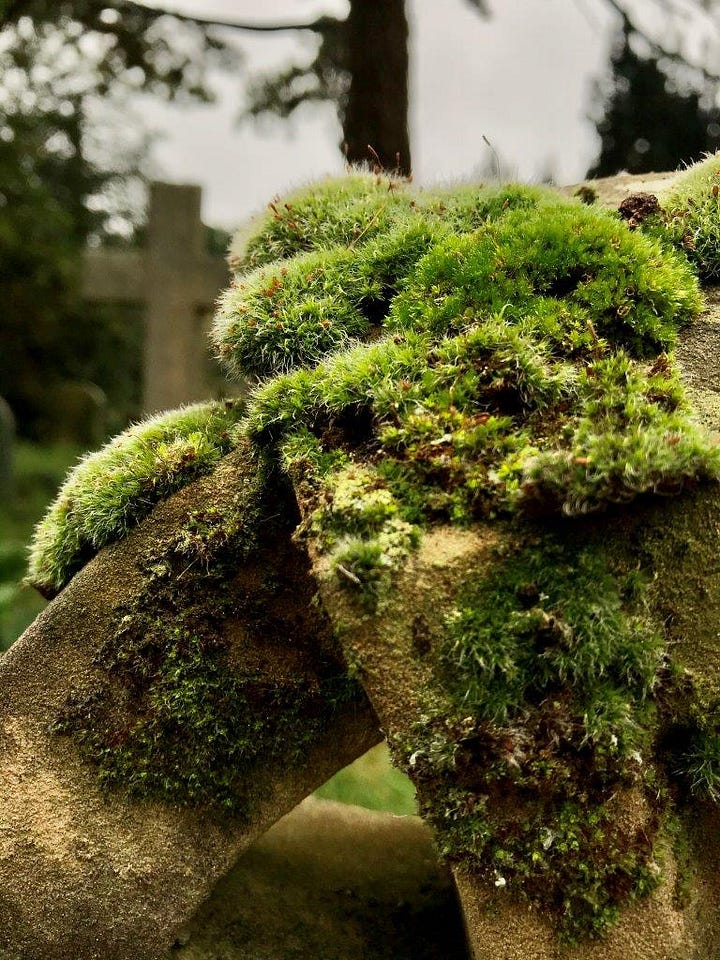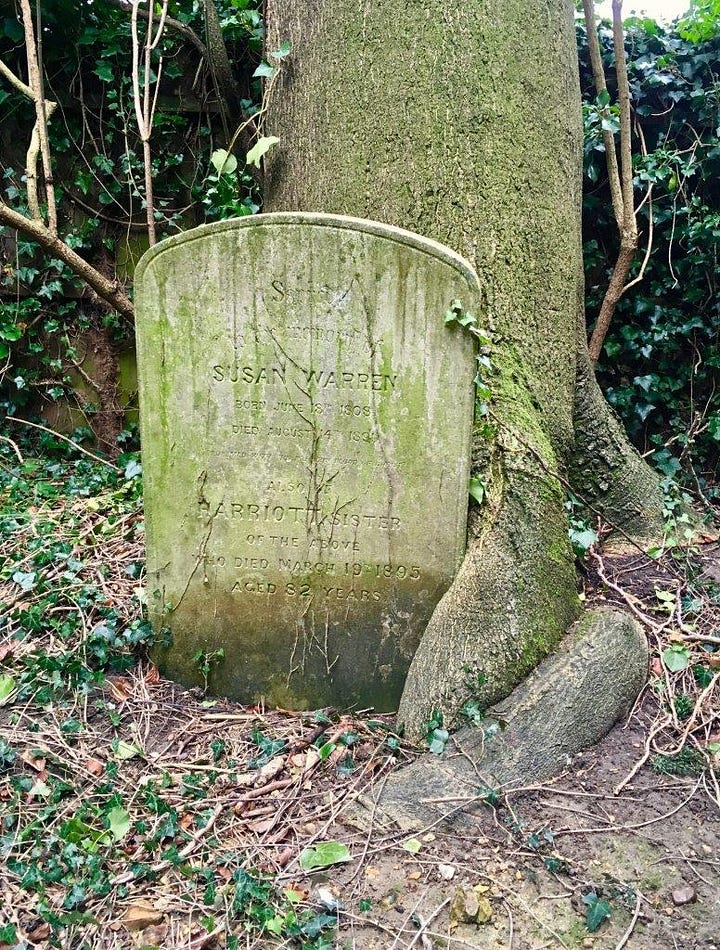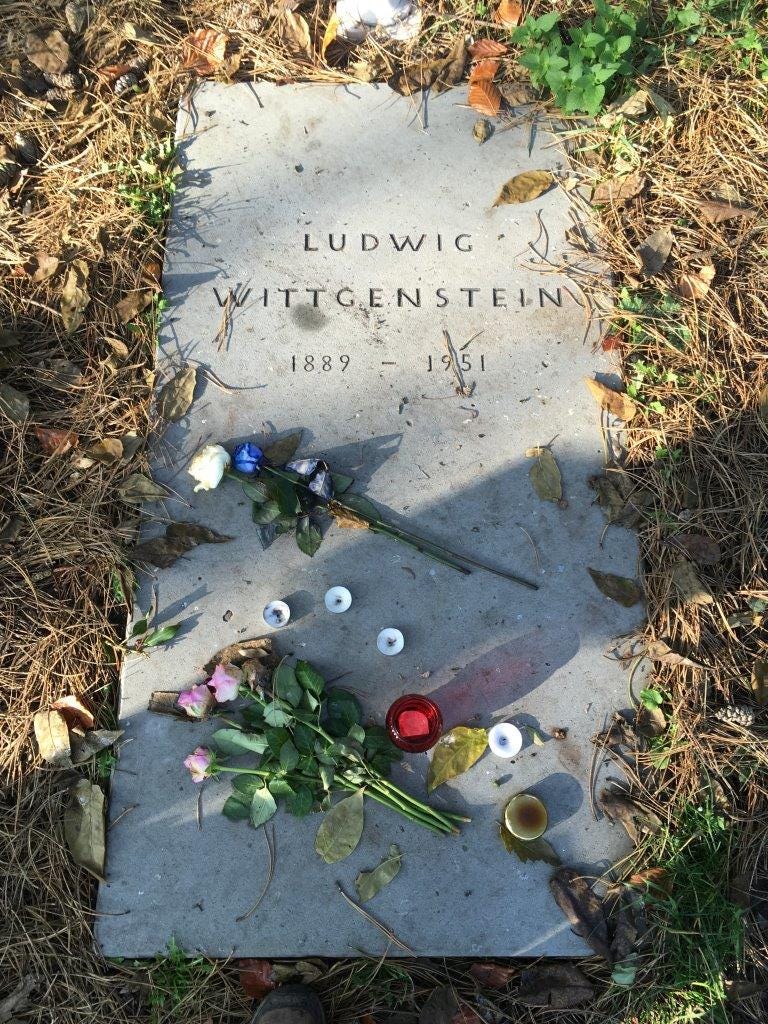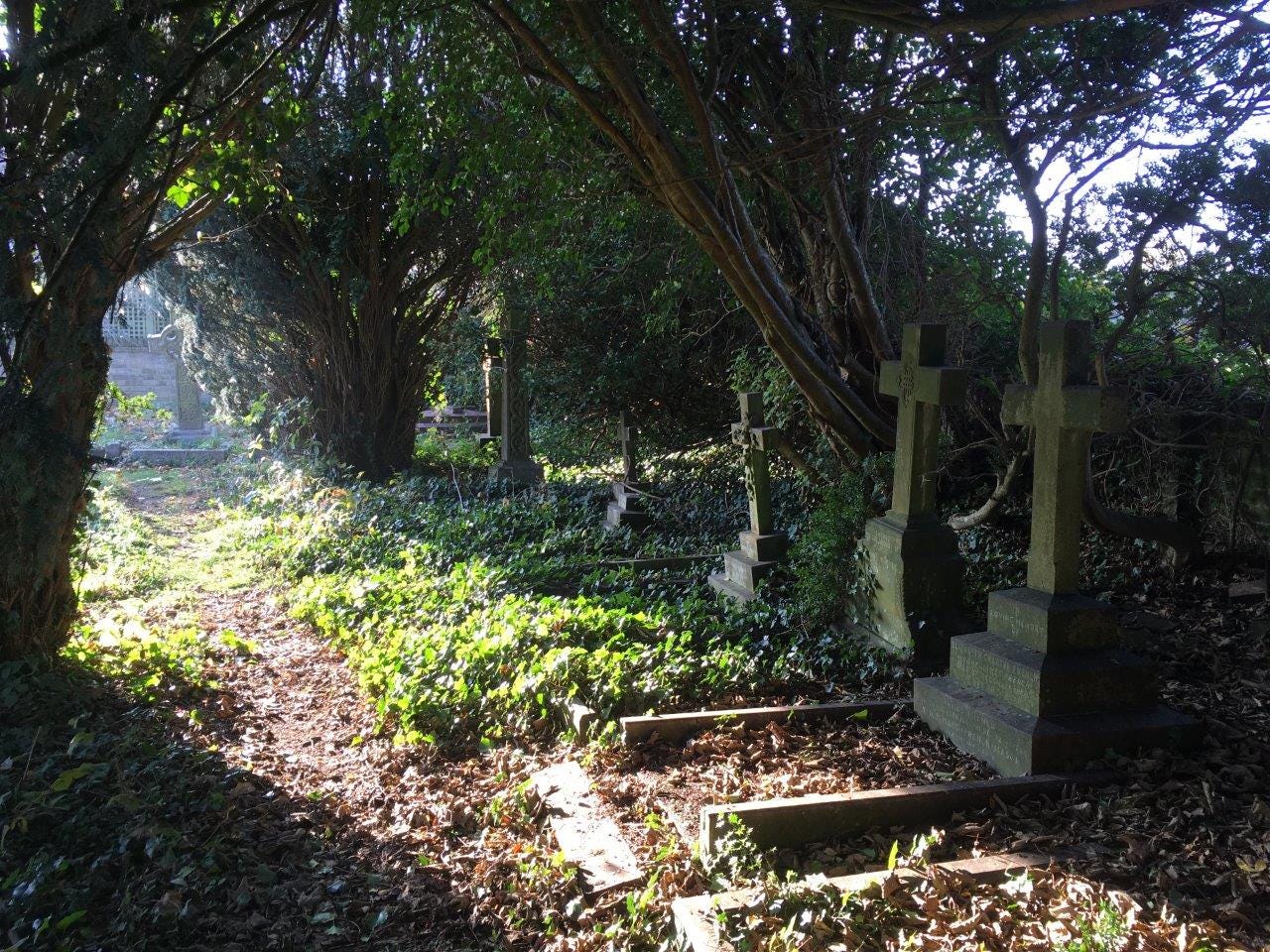Dear friend,
Because today is the fifth Sunday in October, I decided to honor the symmetry of my posting schedule and share something a little different in the meantime. Below is one of my favorite (and highly seasonal) pieces I wrote for my previous blog, The Cambridge Placebook.
I’ve brought over all the text with a few tweaks and a few of the photos, but you can follow this link to see the original post and additional photos. And feel free to have a little poke around The Cambridge Placebook archive, which I think you’ll like. Anne of Green Places is very much a continuation of that project.
(And if you do enjoy it, here’s another reason to consider becoming a paid subscriber to Anne of Green Places: to help me cover the nontrivial web hosting costs of keeping three years of The Cambridge Placebook archives available. A little roundabout, but, like I said, it’s really all the same project!)
A graveyard in England is rife with life. Even in October the graveyard is green. Soil rarely shows, shrouded by a tangle of grass in all stages of growth and senescence, leaves of so many different shapes they lose definition to human eyes, tough stems and new stems, shocks of roots, crowds of brambles, clumps of moss, and even now, flowers, little white clusters of yarrow. In the spring there are snowdrops and daffodils. Under the plants are crawling things, and in the trees are flying things. Footpaths are worn over grass or blanketed in toxic, rust-colored yew needles; headstones are skew like Jack-o’-lantern teeth with a green patina of age and the steady crawl of ivy. If the Friends of the Ascension Parish Burial Ground didn’t have their monthly work parties to keep the life at bay, within months, you wouldn’t know there were any dead kept and remembered here on All Souls’ Lane.
Today’s first task is to scrape ivy off headstones with plastic ice scrapers. It’s always a bit of a shame to strip down those early veins of deep green, the zigging stem with its jaunty emerald leaves, but it’s easy to see the end result of their incursions on headstones that were missed the last few work parties: erasure of monuments, transforming them into topology alone. So I follow the stems down the stone, popping off each juncture of roots, the little gray fan of fibers like centipede legs that have ingratiated themselves with the grain of the rock, sometimes taking flakes of headstone with them as they pull away. I don’t try to uproot the whole endless plant. My job is only to delay.
I think about life and death every time I come here. It sounds cliché, but when I’m kneeling on a grave hacking at plants, the thoughts feel poignant and layered, like the grass. First I think about the contrast between our active party, our eager work and movement across the ground and in the light so symptomatic of our phase of existence, and the silent anonymity of the people the graves are meant to mark. I think about how soon each of our bodies will enter that phase of stillness—sooner, most likely, for the white-haired Friends I’m working with than for me, but the difference between this burst of now and the long tenure of the grave is essentially the same for all of us.
But then there’s the life. As I peel up a mat of moist moss like an oblong toupee off of the stone border of a grave bed, or tear apart weft and warp of grass and rip up ivy runners, I uncover scurrying neighborhoods of pill bugs and millipedes and earwigs and curling earthworms in the damp rich soil, bright yellow snail shells with brown candy-stripes. I disturb spiders of various shapes and sizes from their headstone-ivy webs where they’re neighbors to the letters on the stones, and ladybugs from the nooks and crannies they jewel. Some headstones are held in a woody embrace of tree trunk. Brambles spread even more heartily than the ivy, sending out thick thorny ropes across the ground and plunging pink tips into the soil that burst into knots of root fiber. We use heavy shears and spades and sweat and occasionally blood to tame these.


Of course, there is irony in the role that death (or at least maiming) plays in our task. Here we are, living beings in a graveyard trying to deal death to eager plants to better remember the deaths of our own. But there’s always more life. It’s easy to see the ever-expanding wave of green as one living whole. Knock out a few brambles or uproot a few thistles and Life is none the wiser. We’ve simply made room for more. It’s almost as easy to apply this to ourselves: whether we’re among the sleeping remnants in the graveyard or working in the sun, we’re each a drop in the wave of humanity, or even that same enveloping wave of green. The wave of humanity won’t always persist here, but that bigger wave will, at least as long as the sun lasts.
The Parish of the Ascension church, a familiar English affair of peaked roof, rose window, and cobblestone walls, keeps humble watch over the burial ground, marking where living souls used to perform their ceremonies for the dead. The burial ground only closed to new burials in 2020, but the church has been defunct for quite a while. Now it’s repurposed as a workshop for the stonecutter, Eric Marland, who has etched out many of the more recent headstones. Where there used to be pews—including a long narrow gap along the transept that Eric hypothesizes is where the coffin would stand during a funeral—is now a workbench, and the small chapel is cluttered with half-carved pieces of stone and tools and demonstrations of old lettering. The air is frigid, as it was designed to be, he says, to keep the bodies cold; there was no other morgue. Up on a high, deep windowsill is a painted portrait of a woman in the style of the ‘40s or ‘50s. Eric tells me it’s a painting of his aunt, who loved it here. The portrait is propped on top of a dusty box containing her ashes.
The individuals in the ground outside were all notable on some level, to someone, but some have wider notoriety than others. I’ve more than once heard the quip that this graveyard holds the record for highest collective IQ, for all the Cambridge dons it contains. Ludwig Wittgenstein, the philosopher, is the most famous resident. (Eric the stonecutter was approached by the British Wittgenstein Society to restore Wittgenstein’s grave, and he said that doing so on film while some girls sang plainchant in the background was one of the more surreal experiences of his life.)
Wittgenstein is perhaps followed in fame by several of Charles Darwin’s family members: two sons, two daughters-in-law, and a granddaughter. Frances Cornford, née Darwin, was a poet, and Eric put up a poem of hers in stone on the wall:
All Souls' Night
My love came back to me Under the November tree Shelterless and dim. He put his hand upon my shoulder He did not think me strange or older Nor I, him.
Some grave borders have sunk partly beneath soil, whether because of the same shifting of ground that causes the headstones to heave—fluctuating moisture, freeze-thaw, flow of roots—or, as I like to imagine, because the burying plants and the creatures among them are making their own soil there over the years. Are the bodies and coffins beneath still recognizable or have they also melted into soil? Are one hundred, two hundred years enough for this? Where is Ludwig Wittgenstein in the life cycle of this lush crust of ground? What does Frances Cornford look like now? Would she think herself strange?
This graveyard was not untouched by war. You can find memorials to pilots and servicemen killed in combat or accidents. In one tree-curtained corner there’s a strange, square concrete structure with rough windows. I’m told it was an anti-tank barrier, a pillbox, relict of the second world war, positioned to slow the possible onslaught of enemies bringing new death. They never came, at least not by land. Death persisted here only as the sleep of burial.
Today, like many English graveyards, Ascension Parish Burial Ground is a wildlife reserve. Despite our shears, we want life here. There’s something about the graveyard—whether our work plays a role in this or not—that cradles diversity of life in a way the neighboring fallow field, an apparent monoculture of dandelions, doesn’t. Our trimming and uprooting are only to keep a touch of human order, at least for our moment. We keep the graves visible, slow the overtake of brambles, and leave the wildflowers, the bird and deer habitat, the creeping things and the rich soil. We cultivate a haven for them and for us. When I inhale the breath of the leaves here, plunge my hands into the chaos of grass and the details of the damp soil, walk in the shade of yews, and admire the work of cells rioting for their place in the sun or under the dirt, I feel my place in this wave of life I’m riding. And I thank the God of the graveyard and the turning earth for all of us.







This is so lovely, Anne. Such a beautiful, fascinating graveyard.
Lovely piece, Anne. I grew up in Sheffield and lived near two cemeteries.
The first was the gaveyard of the old Quaker Meeting House, where we lived when I was very young. The second was the General Cemetery, opposite my road for most of my childhood.
The General Cemetery was also a nature reserve, and a park. I walked through it almost every day. Quite a knot of memories of that place.
I remember talking to a Spanish student at Uni who was horrified by how unkempt our graveyards are. How disrespectful. But even when we cut back the brambles, it always feels they should be a little wild.